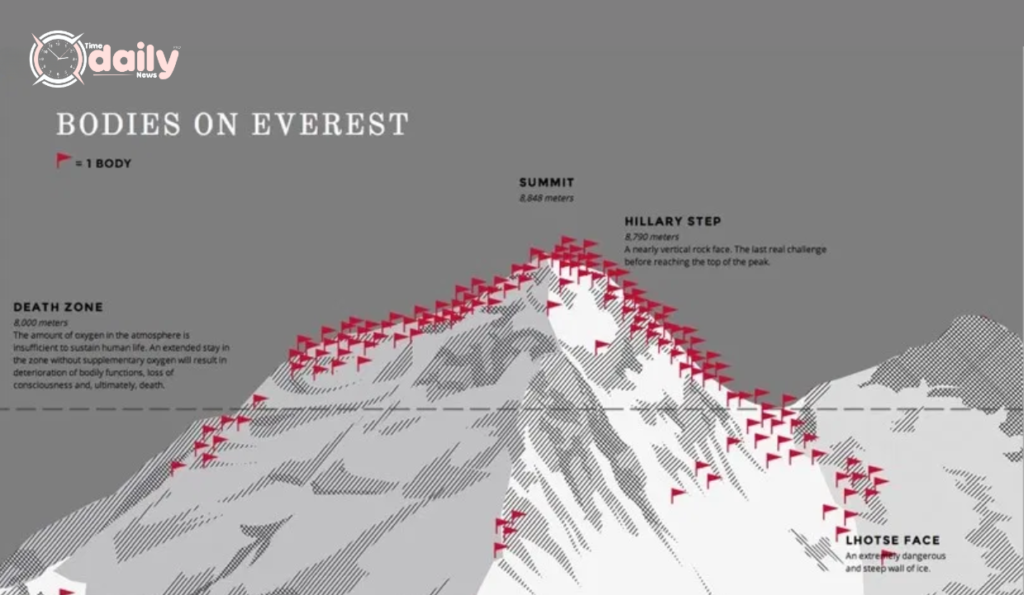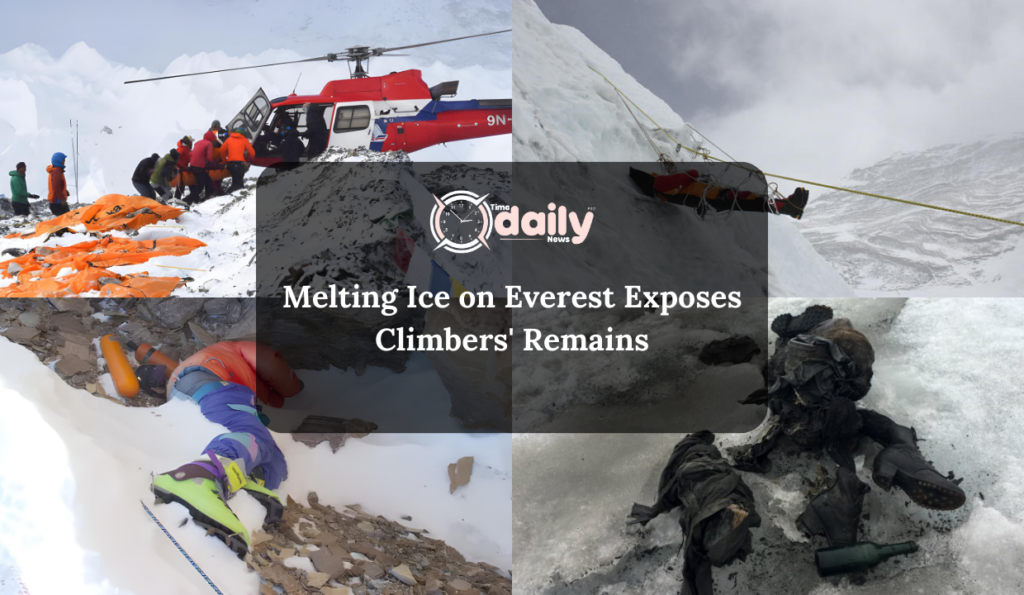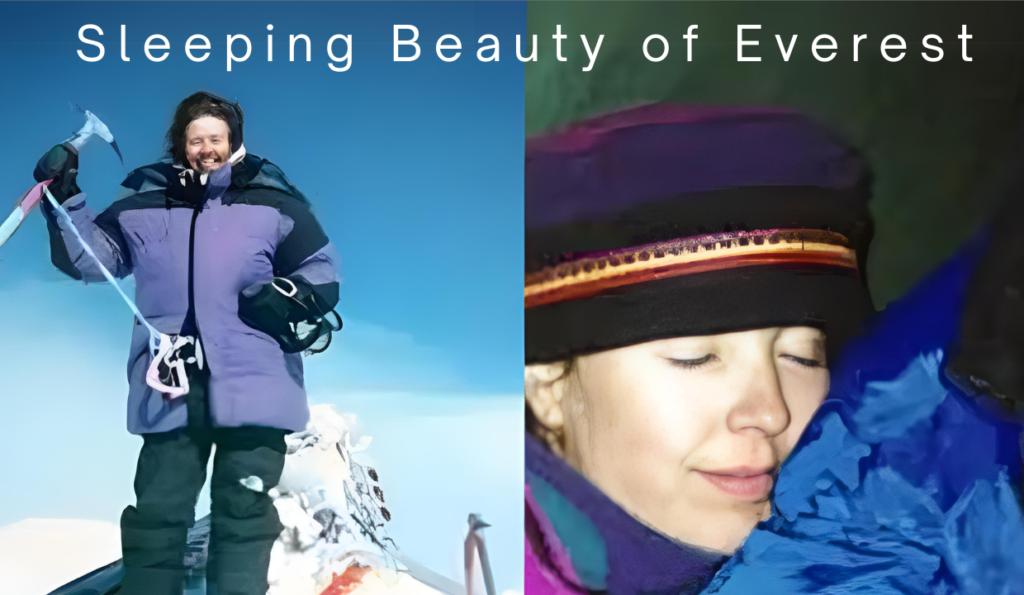Melting Ice on Everest Exposes Climbers’ Remains
The climbers conquer the mountain which is the uppermost point on the earth’s surface- Mount Everest, and reflects human desire and determination. However, it now stands as an alarming symbol of climate change and its devastating effects that will automatically play out should the status quo remain unchanged. The melting ice on Everest is revealing a grim sight—bodies of climbers who perished in the dangerous “Death Zone.”
The Grim Reality of Melting Ice on Everest
In this research, it has been discovered that climate change is altering the natural environment of Mount Everest greatly. It has been precipitating menacingly and the ice and snow that used to thrive in the mountain due to its cooler climate are disappearing at an alarming rate due to rising global temperatures. This has led to rapid melting ice on Everest and the revealing of the bodies of climbers who perished on the mountains whilst gaining the peak. These tantamount revelations only prove and emphasize the effects of climate change and proliferation to even uncharted corners of the world today.
Historical Context
Some of the most famous mountains include Mount Everest which has been attracting climbers for years since the first successful expedition in 1953 by Sir Edmund Hillary and Tenzing Norgay. As years passed, thousands tried to touch the top of this world’s highest peak with over 300 climbers’ lives being taken. Of course, the fascination with the mountain is in the difficulty of changing its face you are a daring climber and face risks that have claimed hundreds of lives.
The Death Zone Explained

The Death Zone is presupposed to be above 8,000m which is 26,247 feet where it becomes impossible to get enough oxygen to survive for several hours. In this zone, risks are very high; severe forms of hypoxia, severe atmospheric and climatic conditions and exhaustion. Gaining altitude is incredibly tiring for the human body due to oxygen depletion which makes every step a struggle They call it the Death Zone since any error at this stage is fatal.
Emotional Impact on Climbers
In the current time, the climbers who come across bodies of other climbers who perished during the ascend bear with the grisly sight that is both sad and overwhelming. They go against the sacred kind of interaction, which people expect on mountains. Seeing dead bodies or bodies frozen in the ice is a very compelling message to understand and respect the mountain, and the strive it poses to those intending to overcome it.
Efforts to Clean Up Everest
Recently, due to the rise in external exposure and exposed dead bodies and related debris, the Nepali authorities have started organizing campaigns to recycle Everest and other adjacent mountains, Lhotse and Nuptse. These missions are carried out by Nepali military personnel in groups for search and rescue missions and experienced climbers. They recently retrieved five more bodies that were entombed in ice, demonstrating the group’s continuous attempts to preserve the mountain’s sacredness.
Challenges of Body Retrieval
Granting the corpses to the families is not easy as the process of collecting the bodies from Mount Everest is very risky and difficult. They result in hard situations in the Death Zone to sort and conduct the movement of the remains. In the worst cases, rescuers can take up to eight rescuer teams to recover one dead body that can weigh as much as 220 pounds or even more. The risks, which are involved in these missions are high, nonetheless, these missions are important in a bid to avert making the mountain to be a burial ground.
Role of Nepali Military and Climbers
Major Aditya Karki, leading the clean-up operation team, has highlighted the significance of these rescue missions. This is mainly because Nepali military personnel and climbers play a crucial role in preserving the sanctity of the mountain and in the remembrance of the lives that were lost. Their commitment and hence, their valor, go a long way into contending with this daunting exercise.
Legal and Ethical Considerations
As stated by the Nepalese, the responsibility of searching for bodies on the mountain belongs to the government departments. It must be noted that this legal framework ensures that the process is done with dignity and in a professional manner. However, it also poses certain ethical concerns regarding the price that is involved and the probable consequences in the process. If there is one thing that is quite impressive about the efforts to recover the dead bodies of the victims of disasters, is that there is always a tough balance between the need to pay respect to the dead and at the same time taking precautions to ensure that the rescue team is also safe.
Global Warming and Glacial Melt
It has been evident from research relating to glaciers in the Everest region that they are receding sharply because of global warming. According to a survey conducted in the year 2015 about the Khumbu Glacier, it was found that the pond area on the glacier is increasing and certain ponds are even joining together because of enhanced glacial melting. In 2016, similar to the above case of Imja Lake, the Nepalese army had to drain excess water from around the lake as it led to glacial meltwater. These reviews and observations also underscore the indispensability of correctly combating climate change and its impacts on the region.
Recent Findings

The warmer months have been associated with increased discovery of corpses particularly on the Tibetan side of the mountain. Tshering Sherpa, for instance, has asked questions about the accelerated melting ice on Everest. Their remains which have taken decades buried tenderly and carefully being exposed to the global warming effects.
Sleeping Beauty of Everest

Another dramatic experience on the peak of Everest is that of Francys Arsentiev – the ‘face’ of the sleeping beauty of Everest It should be noted that in 1998, she became the first American woman to climb Mount Everest’s top while using no additional oxygen, but died during the descent. Her body had been left on the mountain for years and became for many people one of the most significant icons of the real dangers the climbers confront. The three bodies of a sad and lonely woman lying there for years send a message on how deadly Everest can be and the essence of the challenges in the mountain.
Preserving the Sanctity of the Mountains
In this regard, the primary goal of every climber and authority is to ensure that the status of Everest as the ultimate spiritual site is properly maintained. Tributes to the lives lost to their ambitions should always be accorded. Strategies to control dirt and politeness in the mountain still prevail, which enhances the obligation of raising suitable climbing tenets.
Responsible Mountaineering
The idea of taking responsibility for a specific mountain is perhaps the loudest that it has ever been heard. People are encouraged to practice ascending safely and responsibly, bear the environment and the history of these marvelous giants with reverence. This includes reducing the effects of the global environment on oneself and recognizing and appreciating the efforts of elders.
Melting Ice on Everest: Symbol of Tragedy and Conservation Efforts
Mount Everest remains a symbol of modern fascination more so due to the difficult climb associated with it. However, the instance of melting ice on Everest that has led to the revealing of the dead bodies of climbers, reminds the real tragedy of the real world and the devastating issue of losing nature or climate change. While attempts are being made to restore the Himalayan giant and define specific conservation and management strategies, the public urge for responsible and ethical climbing also rises. It is not only a great stone that one can climb and conquer but a symbol of overcoming spirit and humanity’s responsibility to preserve its home. Stay informed with the latest updates on global environmental challenges and more at Time Daily News.
FAQs
Why is Everest’s ice melting so rapidly?
The rapid melting ice on Everest is primarily due to climate change, which has led to rising global temperatures and accelerated glacial melt.
How many bodies are believed to be on Everest?
It is estimated that over 200 bodies remain on Mount Everest, many of which are now being exposed due to melting ice on Everest.
What are the main dangers of the Death Zone?
The main risks involved with the Death Zone include hypoxic conditions, severe weather conditions and exhaustion which are fatal in the region.
How can climbers prepare for these risks?
These risks can be prevented by climbers carrying out several practice sessions, getting proper fitness training and preparation, using oxygen besides their regular oxygen, and, of course, knowing their bodies’ limits.
What steps are being taken to reduce the impact of climate change on Everest?
Efforts to reduce the impact of climate change on Everest include initiatives to clean up debris, improve waste management practices, and raise awareness about the importance of sustainable mountaineering.



